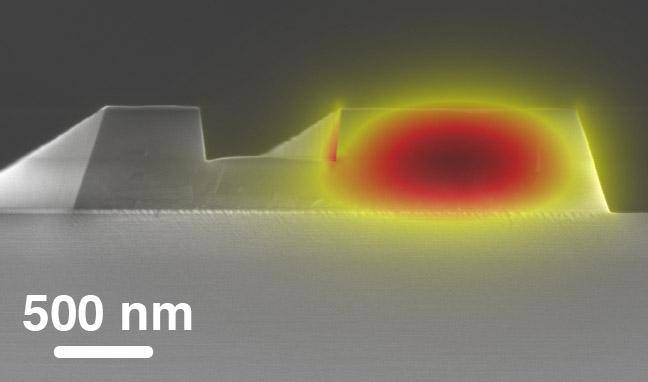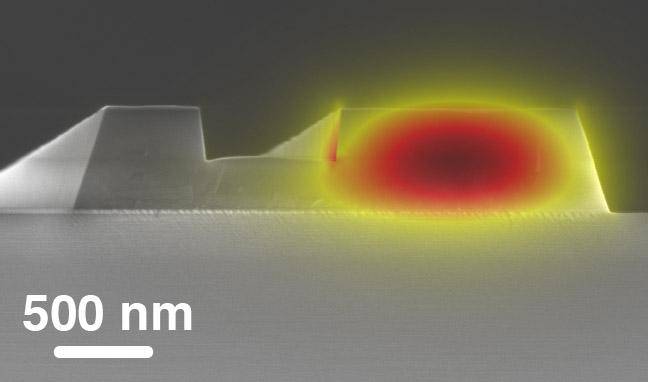
Credit: National Institute of Standards and Technology, Applied Physics Division, Quantum Nanophotonics group
WASHINGTON, D.C., March 15, 2018 — Chemical compounds all carry distinctive absorption "fingerprints" within the mid-infrared spectral region of 2 to 12 microns. This offers an opportunity to measure and study chemicals at extremely sensitive levels but researchers lack the tools, like lasers and detectors, needed to operate within the mid-infrared. Recently, there's been a push to develop new tools to help see and measure these chemical compounds in greater detail.
In a breakthrough, a group of researchers at the National Institute of Standards and Technology developed an on-silicon-chip laser source with outputs that consist of precisely defined and equally spaced optical lines within the mid-infrared spectral region. They report their findings in APL Photonics, from AIP Publishing.
These lasers, called frequency combs, "act as 'rulers' of light and have numerous applications — from transferring time standards and improving GPS signals to precision spectroscopy," said Nima Nader, a postdoctoral researcher for NIST.
For spectroscopic applications, this type of coherent light source can pass through a sample cell containing unknown gases. These gases absorb some of the light and leave behind fingerprints on very specific comb lines. Researchers can check these lines against a database of gases to identify the specific chemicals present.
Beyond this, the coherent nature of the laser source "enables long-distance propagation of light so chemical samples can be studied remotely, without direct contact," Nader said. "And since frequency combs are stabilized laser sources, they can detect very low levels of chemicals and enhance the sensitivity of our measurements."
These sources are fabricated on a compact, silicon-based integrated photonics platform, which enables hundreds of devices — in this case, frequency combs — to be fabricated on a single small-area die.
"Each device is engineered to generate a mid-infrared spectrum of comblike optical lines with tailored spectral shape, bandwidth, and optical power distribution," Nader said.
These laser sources are "as coherent and low-noise as conventional frequency combs developed prior to our work," Nader said. "We also reported, for the first time, dual-comb spectroscopy of a gas sample with a mid-infrared frequency comb source that exploits a silicon-photonic platform."
These developments improve conventional techniques such as Fourier-transform-infrared spectroscopy. A practical, broadband, low-noise mid-infrared frequency comb with moderate power and engineered spectrum may improve the frequency precision, sensitivity, and data acquisition rates of mid-infrared spectroscopy.
"Our user-controlled and engineered multiband spectra are ideal for applications in which parallel multicomb operation is desired — such as point sensors for real-time in situ chemical synthesis monitoring, near-field microscopy, and remote sensing," Nader said. "These sensors can significantly increase the detection sensitivity of tools and techniques such as breath analyzers, cancer detection, explosives tracking and detection, and drug synthesis monitoring."
The next step is to push the optical bandwidth of NIST's frequency combs to longer infrared wavelengths and higher optical powers. "We're also working to reduce their footprint and power consumption to create compact systems with improved efficiency," Nader said.
###
The article, "Versatile silicon waveguide supercontinuum for coherent mid-infrared spectroscopy," is authored by Nima Nader, Daniel L. Maser, Flavio Caldas da Crus, Abijith Kowligy, Henry Timmers, Jeffrey Chiles, Connor Fredrick, Daron A. Westly, Saw Woo Nam, Richard P. Mirin, Jeffrey M. Shainline, and Scott Diddams. The article appeared in the journal APL Photonics March 6, 2018 (DOI: 10.1063/1.5006914) and can be accessed at http://aip.scitation.org/doi/full/10.1063/1.5006914.
ABOUT THE JOURNAL
APL Photonics is the dedicated home for open access multidisciplinary research from and for the photonics community. The journal publishes fundamental and applied results that significantly advance the knowledge in photonics across physics, chemistry, biology and materials science. See http://scitation.aip.org/content/aip/journal/app.
Media Contact
Julia Majors
[email protected]
301-209-3090
@AIPPhysicsNews
http://www.aip.org
Related Journal Article
http://dx.doi.org/10.1063/1.5006914





